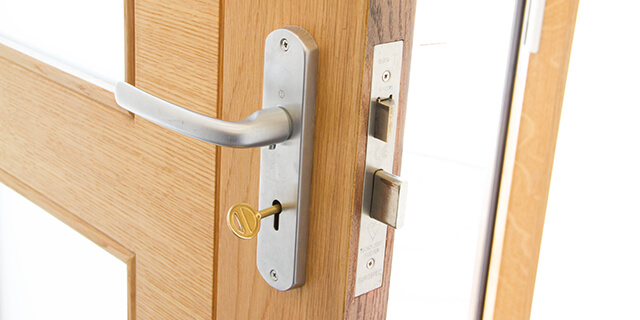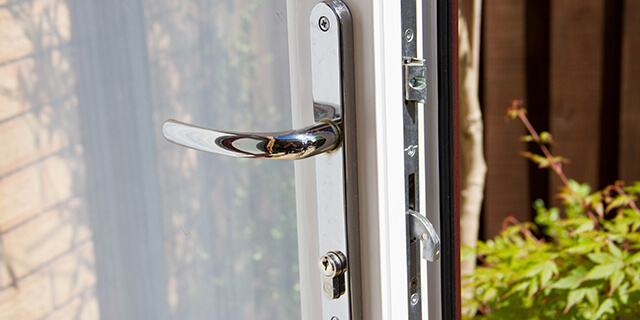INSURANCE APPROVED DOOR LOCKS
Home insurance companies approve certain types of locks for your house. These are the most secure types and conform to British Standards (BS3621).
When you’re looking for a home insurance policy, you’ll be asked what type of locks you have on your exterior doors and windows.
If you wrongly guess which locks are installed and then get burgled, your insurer could refuse to pay your claim.
So it’s really important to get them right - and we’ll help you work out which ones you have.
Key points
- Insurers approve certain locks for your doors and windows
- Claims could be rejected if you note down the wrong locks when you buy the policy
- Approved locks can reduce the cost of your premiums
TYPES OF DOOR LOCKS
Most homes are secured by one or more of these types of locks
1. Five lever mortice deadlock
The five lever mortice deadlock is a type of door lock commonly fitted to wooden doors. It can be locked and unlocked with a key from both the inside and the outside.
It works by inserting and turning the key to move the five levers into the correct position, allowing the bolt to be locked or unlocked.
Its designed to make lock picking and drilling difficult, making it a popular choice of lock for meeting home insurance security requirements.

How to identify a five lever mortice lock
You can often identify a five lever mortice deadlock by the following:
- The words '5 Lever' engraved on the internal faceplate of the lock
- Mostly found on wooden doors. You can’t fit them to uPVC, aluminium or composite doors
- Locks and unlocks from the inside and outside with a key
- The lock sits within the frame of the door
How to tell if a five lever mortice deadlock conforms to BS3621
If your lock is BS3621 approved, the faceplate of the locking mechanism should be stamped with a British Standard Kitemark and the code BS3621.
The BS3621 marking denotes the lock has been tested against common burglary techniques, such as lock picking and drilling, by the British Standards Institution (BSI Group).
If your mortice deadlock isn't BS3621 approved, your door may have a night latch fitted for added security.
2. Rim automatic deadlatch with key locking handles
A rim automatic deadlatch with key-locking handle is a door latch that’s locked and unlocked with a handle from the inside and a key from the outside.

It’s often used as an additional security measure rather than the main lock.
If you do use it as the main lock, your insurance might be more expensive as it’s not the safest solution.
3. Key-operated multi-point locking system
A multi-point locking system has a minimum of three locking points - these all lock simultaneously when you turn the key.
This type of lock is most common on patio or French doors - typically uPVC doors - and not on your main entrance.
If you have a multi-point lock on your front door, your insurer will assess the risk and your insurance might be more expensive.

It’s often used as an additional security measure rather than the main lock.
If you do use it as the main lock, your insurance might be more expensive as it’s not the safest solution.
3. Key-operated multi-point locking system
A multi-point locking system has a minimum of three locking points - these all lock simultaneously when you turn the key.
This type of lock is most common on patio or French doors - typically uPVC doors - and not on your main entrance.
If you have a multi-point lock on your front door, your insurer will assess the risk and your insurance might be more expensive.
4. Euro cylinder locks
Euro cyclinder locks, also known as pin tumbler locks, are a common lock type of lock fitted to external front and back doors.
It works by turning the key to rotate the inner cam, which in turn moves the lock bolt, unlocking or locking the door.
Cylinder locks are sometimes vulnerable to lock snapping, a method used by burglars to break into properties. Because it’s an easier lock to break, some insurers won't cover properties with euro cylinder locks.
5. Key operated security bolts
Key operated security bolts are commonly found on wooden doors, like French and double doors. Concealed within the frame of the door, the lock is usually only operational from the inside via a rack bolt key.
Your insurer may request that these are fitted to both the top and bottom of the door for added security.
6. Padlocks
Shackle padlocks are the go-to lock for sheds, gates and chains because they’re easy to fit locks, that are operated by a key or a pincode combination.
They generably offer little security due to the ease with which they’re broken via bolt cutters or saws.
TYPES OF PATIO DOOR LOCKS
Patio and French doors will usually be fitted with either a:
- Multi-point locking system
- Top or bottom key operated lock
- Central rail key operated lock
The top or bottom lock will have the most basic level of security of the three. It’s usually used along with one of the other types of locks.
If your French doors are wooden, a lock should always be fitted at 90 degrees to the grain of the wood.
That should stop it splitting if someone tries to break in by forcing the door.
ACCESSIBLE WINDOWS AND KEY-OPERATED LOCKS
All your windows should be protected by key-operated locks and it might be a requirement of your insurance policy, particularly for ground floor windows.
Key-operated locks on windows are normally located on the handle used to open the window, although this will depend on the style, age and type of window fitted.
Accessible windows are on the ground floor or basement level, or within easy reach of the ground and capable of being opened (a first-floor window above a flat-roofed, single-storey extension for example.)
This also applies to skylights and rooflights.
HOW MUCH DOES IT COST TO REPLACE A LOCK?
In 2023, the Master Locksmiths Association said the cost to replace or change a mortice, night latch, patio door, or uPVC lock were as follows:
- Changing a mortice lock will cost upwards of £115, but the price of just the mortice without labour starts from £18
- Prices start from £90 to replace a night latch (Yale lock) on a wooden door,
- Replacing a patio door lock starts from £90
- Changing a standard euro cylinder lock on a uPVC door starts from £85, but an anti-snap euro cylinder on a uPVC door is more expensive, starting from £110
ADDITIONAL SECURITY
Night latches add another layer of security to your doors and installing one could get you a discount on your home insurance.
Weigh up whether the cost of getting one installed will be worth it before you buy by checking home insurance quotes.
WHY ARE APPROVED LOCKS WORTH IT?
First and foremost, approved locks can keep burglars out your home.
They can also mean cheaper home insurance premiums, as your insurer will classify you as a lower risk.
If you fit approved locks and use them correctly, your insurer is more likely to pay out if you make a claim.
That’s because it’ll be satisfied you had taken every step to prevent a break-in.
If you tell your insurer that you have a burglar alarm or that you have locks on your windows, they’ll expect you to use them.
“If your alarm isn’t maintained or you don’t lock your windows, your insurer might refuse to pay out.”
